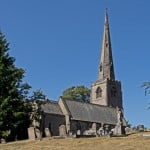Introduction
Ashton Hayes parish was formed in 1849 from the parish of Tarvin. It is named after Ashton Hayes estate and comprises the civil parishes of Ashton, Mouldsworth and Horton-cum-Peel.
Evidence of a settlement by Pentre Brook in Ashton dates back to Roman times when Watling Street passed close by the village. More recently, the Domesday Book of 1086 records that Ashton, then known as Estone, and other land was given to Richard de Vernon for services to William the Conqueror, and that before then, in Saxon times, it was held by a ‘freeman’ named Toret.
A Brief History of the Ashton Hayes Estate.
Ashton Hayes estate dates back to about 1320. It passed through the hands of three generations of a family named Worthington who, in 1780, built the 72 room mansion known as “Ashton Hayes” – the building was demolished as recently as 1957 and is remembered by a number of today’s local residents. A gentleman named Booth Grey bought the property in 1805 and lived there until 1839. Then the estate, consisting of 1658 acres of land, was sold to William Atkinson, the builder of the church.
William Atkinson (1797-1883) was a textile manufacturer from Knaresborough in Yorkshire with business interests in Lancashire. He paid for the building of the church, school and vicarage and made improvements to the living conditions of his tenants. In 1872 he went to live in Southport where he built two further churches, a library and art gallery. Atkinson was very generous to Ashton and Southport, but it should be remembered that fortunes such as his came from the terrible working conditions endured by women and children in Victorian factories and workshops.
When William Atkinson left for Southport, he sold the estate to the executors of Thomas Parr, a banker of Warrington, who had died in 1870. They bought Ashton Hayes for the eldest son, Thomas Philip Parr.
A copy of the front page of a hymn book used at the
1849 Consecration Service. The original is in the
possession of a member of the church.
There were no children of his marriage and when he died in 1891 the estate went to his brother, Joseph Charlton Parr, who gave it to his son Roger, on his coming of age in 1895. Roger Parr chose not to live on the estate and let the house to a Mr. William Hayes, then to a Miss Hayes. In 1909 Major Ernest Johnson became the tenant.
In 1923 the Parr trustees offered for sale at auction the Ashton Hayes estate, then totalling 2607 acres and comprising most of Ashton, Mouldsworth and Horton-cum-Peel. The house and parkland comprising 206 acres were bought by the tenant, Major B. Johnson. Many other tenants took the opportunity to buy their own houses, small holdings or farms, thus bringing to an end the existence of this large estate. After Ernest Johnson’s death in 1930 his wife Mrs Violet Johnson became the owner and for the next 20 years was much involved in the church. She had the Georgian mansion demolished in 1957 to make way for a smaller, more manageable home – this at the age of 85! After she died in 1968 her daughter, Bryony Johnson, lived there until her death in 1985. Her nephew Antony inherited the estate and in 1986 sold the house and gardens to the present owner, Mr. Michael Grime who has done much restoration work.

